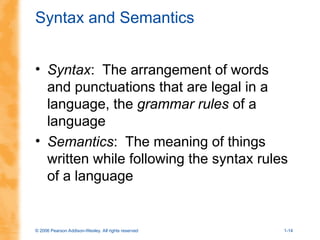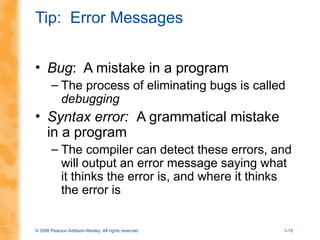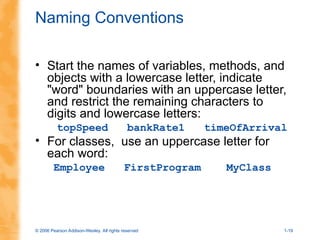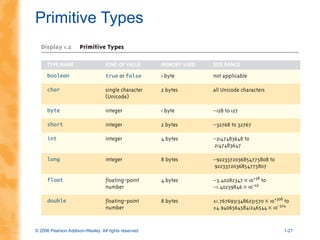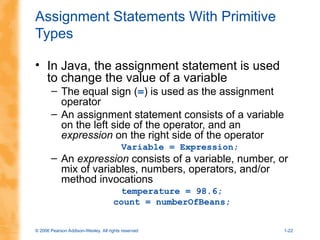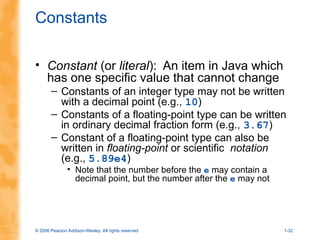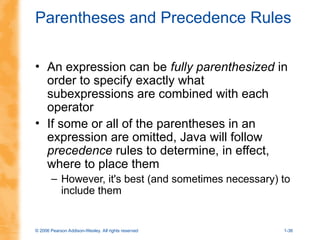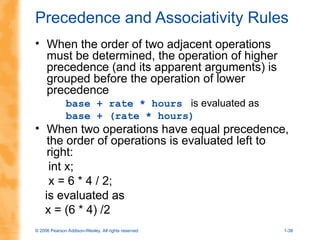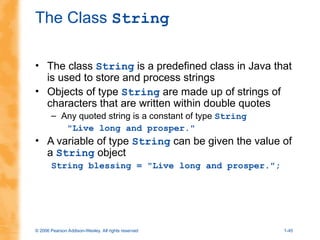savitchAbsJavaPPT Java Programming Part 1
- 1. Slides prepared by Rose Williams, Binghamton University Chapter 1 Getting Started
- 2. © 2006 Pearson Addison-Wesley. All rights reserved 1-2 Introduction To Java • Most people are familiar with Java as a language for Web applications • We will study Java as a general purpose programming language – The syntax of expressions and assignments will be similar to that of other high-level languages – Details concerning the handling of strings and console output will probably be new
- 3. © 2006 Pearson Addison-Wesley. All rights reserved 1-3 History of the Java Language • Created by Sun Microsystems team led by James Gosling (1991) • Originally designed for programming home appliances – Difficult task because appliances are controlled by a wide variety of computer processors – To simplify the task, team developed a two-step translation process to avoid having a separate compiler for each class of appliances (which is very costly)
- 4. © 2006 Pearson Addison-Wesley. All rights reserved 1-4 Origins of the Java Language • Two-step translation process 1) Developed an intermediate language that is the same for all types of processors : Java byte-code 2) Needed an easy to write program called the interpreter to translate byte-code into the machine code for each processor
- 5. © 2006 Pearson Addison-Wesley. All rights reserved 1-5 Objects and Methods • Java is an object-oriented programming (OOP) language – Programming methodology that views a program as consisting of objects that interact with one another by means of actions (called methods) – Objects of the same kind are said to have the same type or be in the same class
- 6. © 2006 Pearson Addison-Wesley. All rights reserved 1-6 Java Application Programs • There are two types of Java programs: applications and applets • A Java application program or "regular" Java program is a class with a method named main – When a Java application program is run, the run- time system automatically invokes the method named main – All Java application programs start with the main method
- 7. © 2006 Pearson Addison-Wesley. All rights reserved 1-7 Applets • A Java applet (little Java application) is a Java program that is meant to be run from a Web browser • In contrast, application programs may have a Graphical User Interface or Console Interface (input read from the console and output written to the console)
- 8. © 2006 Pearson Addison-Wesley. All rights reserved 1-8 A Sample Java Application Program
- 9. © 2006 Pearson Addison-Wesley. All rights reserved 1-9 System.out.println • Java programs work by having things called objects perform actions – System.out: an object used for sending output to the screen • The actions performed by an object are called methods – println: the method or action that the System.out object performs
- 10. © 2006 Pearson Addison-Wesley. All rights reserved 1-10 System.out.println • Invoking or calling a method: When an object performs an action using a method – Also called sending a message to the object – Method invocation syntax (in order): an object, a dot (period), the method name, and a pair of parentheses – Arguments: Zero or more pieces of information needed by the method that are placed inside the parentheses System.out.println("This is an argument");
- 11. © 2006 Pearson Addison-Wesley. All rights reserved 1-11 Variable declarations • A variable is a value that can change, depending on conditions or on information passed to the program • Variable declarations in Java are similar to those in other programming languages – Simply give the type of the variable followed by its name and a semicolon int answer;
- 12. © 2006 Pearson Addison-Wesley. All rights reserved 1-12 Using = and + • In Java, the equal sign (=) is used as the assignment operator – The variable on the left side of the assignment operator is assigned the value of the expression on the right side of the assignment operator answer = 2 + 2; • In Java, the plus sign (+) can be used to denote addition (as above) or concatenation – Using +, two strings can be connected together System.out.println("2 plus 2 is " + answer);
- 13. © 2006 Pearson Addison-Wesley. All rights reserved 1-13 Program terminology • Source code (or source program): A program written in a high-level language such as Java – The input to the compiler program • Object code: The translated low-level program – The output from the compiler program, e.g., Java byte-code – In the case of Java byte-code, the input to the Java byte-code interpreter
- 14. © 2006 Pearson Addison-Wesley. All rights reserved 1-14 Syntax and Semantics • Syntax: The arrangement of words and punctuations that are legal in a language, the grammar rules of a language • Semantics: The meaning of things written while following the syntax rules of a language
- 15. © 2006 Pearson Addison-Wesley. All rights reserved 1-15 Tip: Error Messages • Bug: A mistake in a program – The process of eliminating bugs is called debugging • Syntax error: A grammatical mistake in a program – The compiler can detect these errors, and will output an error message saying what it thinks the error is, and where it thinks the error is
- 16. © 2006 Pearson Addison-Wesley. All rights reserved 1-16 Tip: Error Messages • Run-time error: An error that is not detected until a program is run – The compiler cannot detect these errors: an error message is not generated after compilation, but after execution • Logic error: A mistake in the underlying program which makes it operate incorrectly – The compiler cannot detect these errors, and no error message is generated after compilation or execution, but the program does not do what it is supposed to do
- 17. © 2006 Pearson Addison-Wesley. All rights reserved 1-17 Identifiers • Identifier: The name of a variable or other item (class, method, object, etc.) defined in a program – A Java identifier must not start with a digit, and all the characters must be letters, digits, or the underscore symbol – Java identifiers can theoretically be of any length – Java is a case-sensitive language: Rate, rate, and RATE are the names of three different variables
- 18. © 2006 Pearson Addison-Wesley. All rights reserved 1-18 Identifiers • Reserved words: Identifiers that have a predefined meaning in Java – Do not use them to name anything else
- 19. © 2006 Pearson Addison-Wesley. All rights reserved 1-19 Naming Conventions • Start the names of variables, methods, and objects with a lowercase letter, indicate "word" boundaries with an uppercase letter, and restrict the remaining characters to digits and lowercase letters: topSpeed bankRate1 timeOfArrival • For classes, use an uppercase letter for each word: Employee FirstProgram MyClass
- 20. © 2006 Pearson Addison-Wesley. All rights reserved 1-20 Variable Declarations • Every variable in a Java program must be declared before it is used – A variable declaration tells the compiler what kind of data (type) will be stored in the variable – The type of the variable is followed by one or more variable names separated by commas, and terminated with a semicolon – Variables are typically declared just before they are used or at the start of a block (indicated by an opening brace { ) – Basic types in Java are called primitive types int numberOfBeans; double oneWeight, totalWeight;
- 21. © 2006 Pearson Addison-Wesley. All rights reserved 1-21 Primitive Types
- 22. © 2006 Pearson Addison-Wesley. All rights reserved 1-22 Assignment Statements With Primitive Types • In Java, the assignment statement is used to change the value of a variable – The equal sign (=) is used as the assignment operator – An assignment statement consists of a variable on the left side of the operator, and an expression on the right side of the operator Variable = Expression; – An expression consists of a variable, number, or mix of variables, numbers, operators, and/or method invocations temperature = 98.6; count = numberOfBeans;
- 23. © 2006 Pearson Addison-Wesley. All rights reserved 1-23 Assignment Statements With Primitive Types – When an assignment statement is executed, the expression is first evaluated, and then the variable on the left-hand side of the equal sign is set equal to the value of the expression distance = rate * time; – Note that a variable can occur on both sides of the assignment operator count = count + 2; – The assignment operator is automatically executed from right-to-left, so assignment statements can be chained number2 = number1 = 3;
- 24. © 2006 Pearson Addison-Wesley. All rights reserved 1-24 Tip: Initialize Variables • A variable that has been declared but that has not yet been given a value by some means is said to be uninitialized • In certain cases an uninitialized variable is given a default value – It is best not to rely on this – Explicitly initialized variables have the added benefit of improving program clarity
- 25. © 2006 Pearson Addison-Wesley. All rights reserved 1-25 Tip: Initialize Variables • The declaration of a variable can be combined with its initialization via an assignment statement int count = 0; double distance = 55 * .5; char grade = 'A'; – Note that some variables can be initialized and others can remain uninitialized in the same declaration int initialCount = 50, finalCount;
- 26. © 2006 Pearson Addison-Wesley. All rights reserved 1-26 Shorthand Assignment Statements • Shorthand assignment notation combines the assignment operator (=) and an arithmetic operator • It is used to change the value of a variable by adding, subtracting, multiplying, or dividing by a specified value • The general form is Variable Op = Expression which is equivalent to Variable = Variable Op (Expression) – The Expression can be another variable, a constant, or a more complicated expression – Some examples of what Op can be are +, -, *, /, or %
- 27. © 2006 Pearson Addison-Wesley. All rights reserved 1-27 Shorthand Assignment Statements Example: Equivalent To: count += 2; count = count + 2; sum -= discount; sum = sum – discount; bonus *= 2; bonus = bonus * 2; time /= rushFactor; time = time / rushFactor; change %= 100; change = change % 100; amount *= (count1 + count2); amount = amount * (count1 + count2);
- 28. © 2006 Pearson Addison-Wesley. All rights reserved 1-28 Type Casting • A type cast takes a value of one type and produces a value of another type with an "equivalent" value – If n and m are integers to be divided, and the fractional portion of the result must be preserved, at least one of the two must be type cast to a floating-point type before the division operation is performed double ans = n / (double)m; – Note that the desired type is placed inside parentheses immediately in front of the variable to be cast – Note also that the type and value of the variable to be cast does not change
- 29. © 2006 Pearson Addison-Wesley. All rights reserved 1-29 More Details About Type Casting • When type casting from a floating-point to an integer type, the number is truncated, not rounded – (int)2.9 evaluates to 2, not 3 • It is illegal to place a double value into an int variable without an explicit type cast int i = 5.5; // Illegal int i = (int)5.5 // Correct i is 5
- 30. © 2006 Pearson Addison-Wesley. All rights reserved 1-30 Assignment Compatibility • In general, the value of one type cannot be stored in a variable of another type int intVariable = 2.99; //Illegal – The above example results in a type mismatch because a double value cannot be stored in an int variable • However, there are exceptions to this double doubleVariable = 2; – For example, an int value can be stored in a double type
- 31. © 2006 Pearson Addison-Wesley. All rights reserved 1-31 Assignment Compatibility • More generally, a value of any type in the following list can be assigned to a variable of any type that appears to the right of it byteshortintlongfloatdouble char • An explicit type cast is required to assign a value of one type to a variable whose type appears to the left of it on the above list (e.g., double to int) int x; double y = 35.5; x = (int)y; x will be set to 35 • In the above example, note that assigning x to y, explicit cast is not required as an implicit cast will be applied automatically: y = x; // no explicit cast needed: y = (double) x;
- 32. © 2006 Pearson Addison-Wesley. All rights reserved 1-32 Constants • Constant (or literal): An item in Java which has one specific value that cannot change – Constants of an integer type may not be written with a decimal point (e.g., 10) – Constants of a floating-point type can be written in ordinary decimal fraction form (e.g., 3.67) – Constant of a floating-point type can also be written in floating-point or scientific notation (e.g., 5.89e4) • Note that the number before the e may contain a decimal point, but the number after the e may not
- 33. © 2006 Pearson Addison-Wesley. All rights reserved 1-33 Constants • Constants of type char are expressed by placing a single character in single quotes (e.g., 'Z') • Constants for strings of characters are enclosed by double quotes (e.g., "Welcome to Java") • There are only two boolean type constants, true and false – Note that they must be spelled with all lowercase letters
- 34. © 2006 Pearson Addison-Wesley. All rights reserved 1-34 Arithmetic Operators and Expressions • As in most languages, expressions can be formed in Java using variables, constants, and arithmetic operators – These operators are + (addition), - (subtraction), * (multiplication), / (division), and % (modulo, remainder) – Example expression: z = w + 2;
- 35. © 2006 Pearson Addison-Wesley. All rights reserved 1-35 Arithmetic Operators and Expressions • If an arithmetic operator is combined with int operands, then the resulting type is int • Similarly, if an arithmetic operator is combined with at double operands, then the resulting type is double • If different types are combined in an expression, then the resulting type is the right-most type on the following list that is found within the expression byteshortintlongfloatdouble char – Exception: If the type produced should be byte or short (according to the rules above), then the type produced will actually be an int • Question: What will be the resulting type of the following expression? float a=11.5f; double b =12.2; a + b
- 36. © 2006 Pearson Addison-Wesley. All rights reserved 1-36 Parentheses and Precedence Rules • An expression can be fully parenthesized in order to specify exactly what subexpressions are combined with each operator • If some or all of the parentheses in an expression are omitted, Java will follow precedence rules to determine, in effect, where to place them – However, it's best (and sometimes necessary) to include them
- 37. © 2006 Pearson Addison-Wesley. All rights reserved 1-37 Precedence Rules
- 38. © 2006 Pearson Addison-Wesley. All rights reserved 1-38 Precedence and Associativity Rules • When the order of two adjacent operations must be determined, the operation of higher precedence (and its apparent arguments) is grouped before the operation of lower precedence base + rate * hours is evaluated as base + (rate * hours) • When two operations have equal precedence, the order of operations is evaluated left to right: int x; x = 6 * 4 / 2; is evaluated as x = (6 * 4) /2
- 39. © 2006 Pearson Addison-Wesley. All rights reserved 1-39 Integer and Floating-Point Division • When one or both operands are a floating-point type, division results in a floating-point type 15.0/2 evaluates to 7.5 • When both operands are integer types, division results in an integer type – Any fractional part is discarded – The number is not rounded 15/2 evaluates to 7 • Be careful to make at least one of the operands a floating-point type using explicit type cast if the fractional portion is needed: (double)15/2 evaluates to 7.5
- 40. © 2006 Pearson Addison-Wesley. All rights reserved 1-40 Unary +,- vs Binary +, - • When +,- are used as unary operators, they operate on one operand: int x=4, y; y = +x; // y becomes 4, note + is redundant y = -x; // y becomes -4 • When +,- are used as binary operators, they operate on two operands: int x=4, y=2, z; z = x + y; // z becomes 6 z = x – y; // z becomes 2
- 41. © 2006 Pearson Addison-Wesley. All rights reserved 1-41 The ! Operator • Called the logical NOT operator • It operates on a boolean expression and reverses it (if true it becomes false and if false, it becomes true double balance=0; if (!(balance > 0)) System.out.println("No money left!"); • The if statement will be covered in Chapter 3.
- 42. © 2006 Pearson Addison-Wesley. All rights reserved 1-42 The % Operator • The % operator is used with operands of type int • It divides left-hand operand by right-hand operand and returns remainder. 15 % 2 evaluates to 1 22 % 2 evaluates to 0 17 % 3 evaluates to 2
- 43. © 2006 Pearson Addison-Wesley. All rights reserved 1-43 Increment and Decrement Operators • The increment operator (++) adds one to the value of a variable – If n is equal to 2, then n++ or ++n will change the value of n to 3 • The decrement operator (--) subtracts one from the value of a variable – If n is equal to 4, then n-- or --n will change the value of n to 3
- 44. © 2006 Pearson Addison-Wesley. All rights reserved 1-44 Increment and Decrement Operators • When either operator precedes its variable, and is part of an expression, then the expression is evaluated using the changed value of the variable – If n is equal to 2, then 2*(++n) evaluates to 6 • When either operator follows its variable, and is part of an expression, then the expression is evaluated using the original value of the variable, and only then is the variable value changed – If n is equal to 2, then 2*(n++) evaluates to 4 – The value of n will then become 3
- 45. © 2006 Pearson Addison-Wesley. All rights reserved 1-45 The Class String • The class String is a predefined class in Java that is used to store and process strings • Objects of type String are made up of strings of characters that are written within double quotes – Any quoted string is a constant of type String "Live long and prosper." • A variable of type String can be given the value of a String object String blessing = "Live long and prosper.";
- 46. © 2006 Pearson Addison-Wesley. All rights reserved 1-46 Concatenation of Strings • Concatenation: Using the + operator on two strings in order to connect them to form one longer string – If greeting is equal to "Hello ", and javaClass is equal to "class", then greeting + javaClass is equal to "Hello class" • Any number of strings can be concatenated together • When a string is combined with almost any other type of item, the result is a string – "The answer is " + 42 evaluates to "The answer is 42"
- 47. © 2006 Pearson Addison-Wesley. All rights reserved 1-47 String Methods • The String class contains many useful methods for string-processing applications – A String method is called by writing a String object, a dot, the name of the method, and a pair of parentheses to enclose any arguments – If a String method returns a value, then it can be placed anywhere that a value of its type can be used String greeting = "Hello"; int count = greeting.length(); System.out.println("Length is " + count); – Always count from zero when referring to the position or index of a character in a string
- 48. © 2006 Pearson Addison-Wesley. All rights reserved 1-48 String Indexes
- 49. © 2006 Pearson Addison-Wesley. All rights reserved 1-49 Some Methods in the Class String (Part 1 of 8)
- 50. © 2006 Pearson Addison-Wesley. All rights reserved 1-50 Some Methods in the Class String (Part 2 of 8)
- 51. © 2006 Pearson Addison-Wesley. All rights reserved 1-51 Some Methods in the Class String (Part 3 of 8)
- 52. © 2006 Pearson Addison-Wesley. All rights reserved 1-52 Some Methods in the Class String (Part 4 of 8)
- 53. © 2006 Pearson Addison-Wesley. All rights reserved 1-53 Some Methods in the Class String (Part 5 of 8)
- 54. © 2006 Pearson Addison-Wesley. All rights reserved 1-54 Some Methods in the Class String (Part 6 of 8)
- 55. © 2006 Pearson Addison-Wesley. All rights reserved 1-55 Some Methods in the Class String (Part 7 of 8)
- 56. © 2006 Pearson Addison-Wesley. All rights reserved 1-56 Escape Sequences • A backslash () immediately preceding a character (i.e., without any space) denotes an escape sequence or an escape character – The character following the backslash does not have its usual meaning – Although it is formed using two symbols, it is regarded as a single character
- 57. © 2006 Pearson Addison-Wesley. All rights reserved 1-57 Escape Sequences
- 58. © 2006 Pearson Addison-Wesley. All rights reserved 1-58 Character Sets • ASCII: A character set used by many programming languages that contains all the characters normally used on an English-language keyboard, plus a few special characters – Each character is represented by a particular number • Unicode: A character set used by the Java language that includes all the ASCII characters plus many of the characters used in languages with a different alphabet from English
- 59. © 2006 Pearson Addison-Wesley. All rights reserved 1-59 Naming Constants • Instead of using "anonymous" numbers in a program, always declare them as named constants, and use their name instead public static final int INCHES_PER_FOOT = 12; public static final double RATE = 0.14; – This prevents a value from being changed inadvertently – It has the added advantage that when a value must be modified, it need only be changed in one place – Note the naming convention for constants: Use all uppercase letters, and designate word boundaries with an underscore character
- 60. © 2006 Pearson Addison-Wesley. All rights reserved 1-60 Comments • A line comment begins with the symbols //, and causes the compiler to ignore the remainder of the line – This type of comment is used for the code writer or for a programmer who modifies the code • A block comment begins with the symbol pair /*, and ends with the symbol pair */ – The compiler ignores anything in between – This type of comment can span several lines – This type of comment provides documentation for the users of the program














